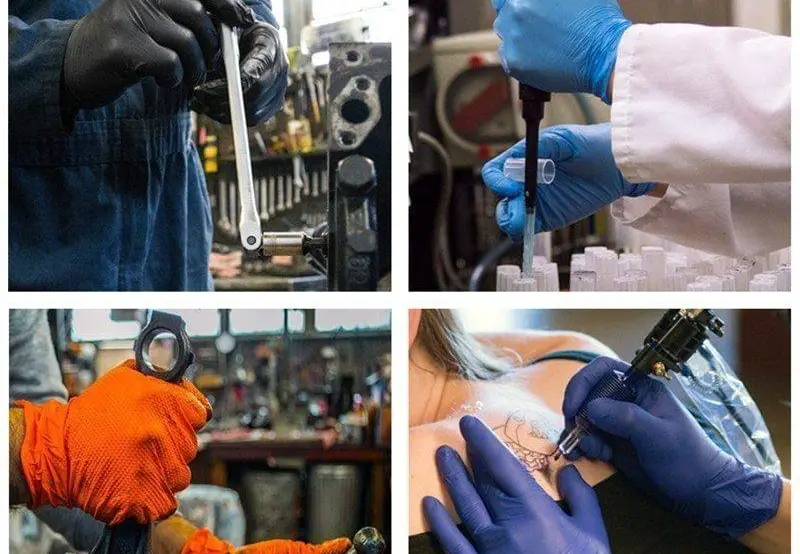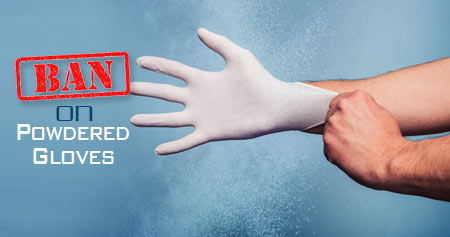There are different types of gloves, per se, latex gloves, vinyl gloves, and nitrile gloves. You might know that all the three types are different. But what’s confusing is whether powder-free gloves mean they’re latex-free too!
Putting things into perspective, the answer is no. No, powder-free and latex-free aren’t necessarily the same thing. However, that’s not always the case.
Latex gloves in themselves are of two types: powdered and powder-free. The difference between the two is that the latter doesn’t have cornstarch powder.
But, they both have latex as long as they’re made of natural rubber. It’s the presence and absence of cornstarch that’s the difference here.

If you’re thinking about what gloves are latex free, then the answer is vinyl gloves and nitrile gloves.
This in-depth article sheds light on the subject, the difference between powder-free and latex-free gloves since these terms can be confusing and used wrongly.
Dive in to make yourself aware with the right information!
Is powder-free the same as latex-free: top 4 facts and myths!
Traditionally, latex gloves used to have cornstarch powder inside them. The purpose of cornstarch was to help the gloves glide easily. However, not long ago, it was discovered that cornstarch in latex gloves was harmful.
As an alternative, powder-free latex gloves were manufactured. The powdered latex gloves, when chlorinated, get rid of traces of cornstarch.
The second purpose of chlorination is to ensure that even if some traces of cornstarch are left behind, they won’t be absorbed by the skin.
Inferring from the aforementioned details, it should be clear that even powder-free gloves have latex when it’s natural rubber in question. It’s the presence and absence of cornstarch that’s the difference.
So, powder-free gloves are not the same as latex-free. If the gloves are made of natural rubber, they will have latex protein whatsoever.
That said, let’s now talk about certain myths and facts that have given rise to this confusion.
#1 Powder-free gloves don’t have latex: it’s a complicated myth
Isn’t this the entire context of even curating this article? It’s absolutely untrue that powder-free gloves don’t have latex.
The name should give it away: if the category of gloves is latex from real rubber, whether or not they’re powdered, they still have latex. That’s that, period!
#2. Powder-free latex gloves don’t cause latex allergy: it’s a myth
As already said, powder-free gloves have latex. What they don’t have is cornstarch. So, even powder-free gloves have the full capability to cause latex allergy.
The chances are certainly less because chlorination reduces the chances of latex protein getting absorbed by the skin, but chances exist still! So, for people with latex allergies, both powdered and powder-free latex gloves are bad.
#3. Latex gloves can be powder-free too: it’s a fact
It should be as clear as the summer sky by now that latex gloves have two varieties: powdered and powder-free!
When chlorinated, latex gloves lose most of the cornstarch. The remnants aren’t absorbed by the skin either. So, non-powdered latex gloves are safer than the powdered version any day.
#4. Powder-free latex gloves are not the same as vinyl gloves: it’s a fact
Powder-free latex gloves are vinyl gloves – says who? They’re both entirely different. Vinyl gloves are synthesized in the first place to replace latex gloves for people who have latex allergies.
So, vinyl gloves do not contain latex, at all!
Powdered Vs Powder-free Latex Gloves: Which ones are better?
Natural rubber gloves will always have latex protein, that’s a fact! The two variations, powdered and powder-free are based on cornstarch. Let’s find out the differences between the two at length.
Powdered latex gloves
Pros
-
-
- The presence of cornstarch makes the gloves easy to wear.
- They won’t get stuck when you’re trying to remove them.
- They’re smoother than the powder-free version.
-
Cons
-
-
- Cornstarch gets stuck on the skin. It poses a serious threat of contamination.
- Cornstarch as well as latex protein easily permeates the skin, causing allergies.
- Cornstarch is a foreign substance for the human body. Hence, the WBCs start fighting the cornstarch molecules. It causes inflammation as well as fever.
-
Powder-free Latex gloves
Pros
-
-
- There’s no risk of contamination since the gloves are free of corn powder.
- There’s no residue left behind when the gloves are removed even after hours.
-
Cons
-
-
- Despite being powder-free, they can still lead to latex allergies.
- They’re less smooth than powdered latex gloves.
- They’re less tensile than powdered latex gloves.
-
So, which one’s better, powdered latex gloves or powder-free latex gloves?
Any day, if the comparison has to be between powdered and powder-free latex gloves, the powder-free version is better because it’s safer.
In fact, the FDA has banned the use of powdered latex gloves for the medical sector.
What are latex-free gloves?
Since you know that powder-free and latex-free aren’t necessarily the same thing, you might want to know which gloves are latex-free. If yes, then let us tell you that the two most popular latex-free gloves are vinyl gloves and nitrile gloves.
Both these latex-free gloves are engineered. They’re both devoid of latex from real rubber. Though, they’re still different from each other.
Which latex-free gloves are better, vinyl or nitrile?
Although vinyl gloves are more popular, nitrile gloves are safer. Want to know why so that you can choose what’s the best? Well, we have the answers and we’ve listed them in the pointers below.
• Latex-free vinyl gloves contain plasticizers and phthalates. Nitrile gloves don’t. So, they’re not risky for health.
• Latex-free vinyl gloves are still non-biodegradable. So, they cause pollution because they can’t decompose. Nitrile gloves, on the other hand, are biodegradable.
• Vinyl gloves can’t protect from acids, ketogenic solvents, and blood-borne pathogens; nitrile gloves can.
Do we need to say anything else as to which of these two latex-free gloves are better? Hands down, nitrile gloves are safer and better.
Now, it might get you wondering why, despite these threats, vinyl gloves are still used? The answer is that they’re affordable.
Vinyl gloves shouldn’t be used for surgeries or under any circumstances where there’s a risk of contamination or contact with bodily fluids. But, they can be used for low-risk jobs like cleaning.
Latex Vs nitrile gloves: what are the differences?
There are many differences between the two, the most important ones are as follows.
1.) Latex gloves are made of natural rubber and nitrile gloves are synthetic.
2.) Although both the gloves are biodegradable, latex gloves decompose fairly quickly. Nitrile gloves, on the other hand, take many years to fully decompose.
3.) Nitrile gloves are safe for people with latex allergies.
4.) Latex gloves aren’t as resistant to punctures, cuts, and wear and tear as nitrile gloves are.
5.) Latex gloves are a tad bit better against bacteria. However, nitrile gloves offer decent protection too.
Why are powdered latex gloves banned?
In 2017, the FDA banned the use of powdered latex gloves in the healthcare setup for a number of reasons.

Other than the obvious that powder can be absorbed into the skin of the healthcare provider wearing these gloves, it can also be absorbed by patients.
Naturally, powdered latex gloves are a serious threat to human health. That’s why they’re banned.
Please, note: there’s still a permissible limit of powder that is still allowed. 2 mg of corn powder/glove is still not unlawful when used by doctors or nurses. However, it’s always better that doctors and nurses wear latex-free nitrile gloves.
FAQs
1. Is latex powder toxic?
If not toxic, it’s at least not appreciated by the body. The body will identify the powder as a foreign molecule and start the defense mechanism automatically.
Besides, long-term exposure to cornstarch leads to serious dermatitis and many other health issues. That’s why powdered latex gloves have been banned in the medical set up by the FDA.
2. Do powdered gloves have latex?
When made of natural rubber, powdered gloves do have latex. On top of that, powder only increases the absorption of latex that can lead to allergies.
3. What are powder-free gloves used for?
First of all, the three major types of powder-free gloves are:
-
-
- Powder-free Latex gloves.
- Powder-free vinyl gloves.
- Powder-free nitrile gloves.
-
So, what powder-free gloves can be used for depends on which of these gloves you’re talking about.
The powder-free latex gloves can be used by lab workers since the risk of contamination is very low and the protection against bacteria and viruses is really high.
The powder-free vinyl gloves can be used for low-risk purposes like cleaning, painting, and printing.
The powder-free nitrile gloves can be used for surgeries and food handling. They can also be used for industrial purposes.
4. Are powdered latex gloves safe?
No, not at all. The FDA has put a ban on their use in the medical set up entirely. They pose serious risks of infections after surgeries and the threat of contamination is too high to be overlooked.
They can also cause life-threatening inflammation of the airway passage.
5. Can you be allergic to powder-free latex gloves?
Yes, absolutely. They might not have cornstarch powder, but they still have latex. And many studies have revealed that every 1 out of 10 people is allergic to latex from natural rubber.
6. Are powder-free vinyl gloves latex-free?
Yes. Vinyl gloves do not have latex at all. They were initially designed for people with latex allergies. That being said, vinyl gloves have problems of their own.
7. Does all rubber contain latex?
If it’s natural rubber that you’re talking about, then yes. Natural rubber will always have latex.
If it’s synthetic rubber like nitrile that you’re talking about, then you should know that synthetic rubber does not contain latex.
Concluding Thoughts
Latex-free gloves can be powdered as well as unpowdered. However, powder-free gloves are not always latex free. As long as the gloves are made of natural rubber, they will contain latex.
Latex-free gloves are vinyl gloves and nitrile gloves. They’re options for people who suffer from latex allergies.
We hope that this guide has resolved all your queries now and that you’ll be able to pick the right glove according to the job that you do!







